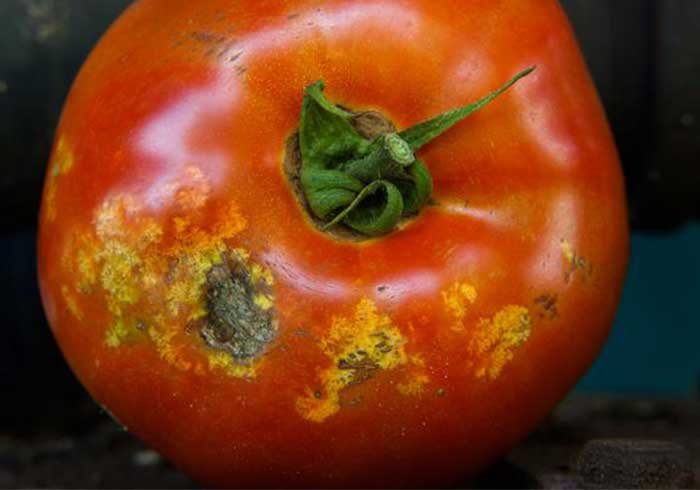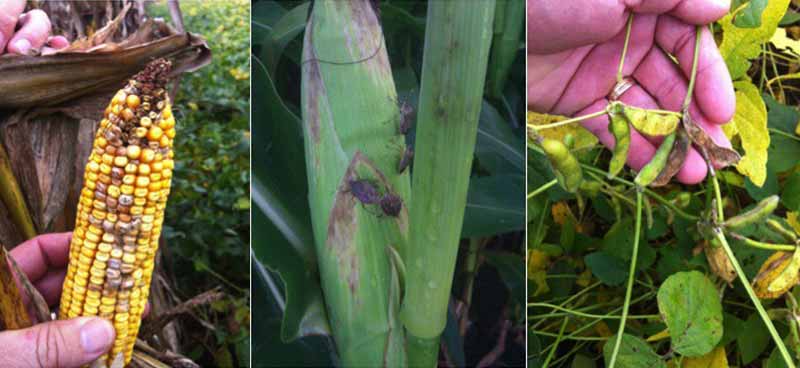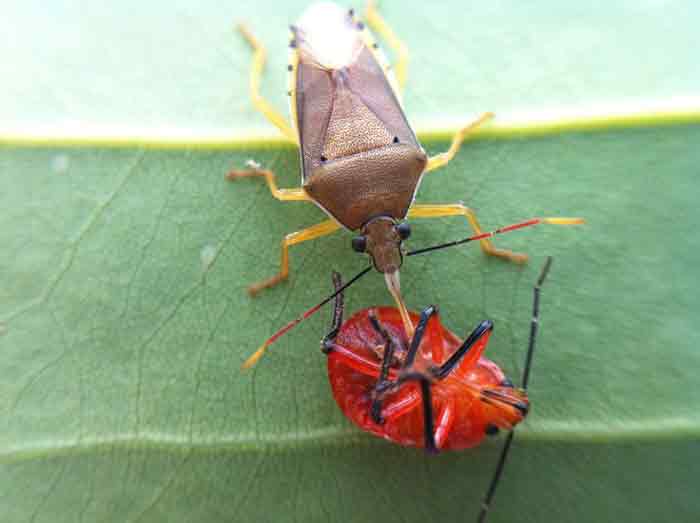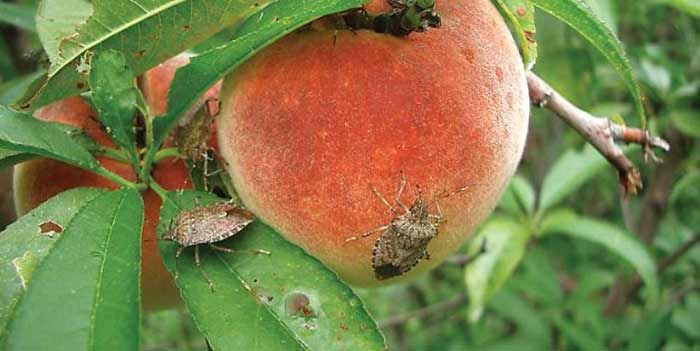Like any other living creature, stink bugs do need to eat and perhaps drink to survive. Both the green and brown marmorated stink bugs mostly feed on plants. There are also predatory species that eat other insects such beetles. Read on to find details on their diet and feeding habits at different stages, plus how long they can stay without a meal while in house or outdoors.
Table of Contents
What do Stink Bugs eat Outdoors & in house?
Stink bugs have rostrums that they use to feed. The rostrums are similar to beaks. This feature makes them majorly vegetarian, feeding on vegetation more specifically, sucking on sap from leaves.
Stink bugs are known to be outdoor pests more than they would be indoor. They therefore spend most of their lives feeding on plants outside.
They are considered polyphagous as preference is not made on particular plant types. This means that they feed off a variety of plants.
Since stink bugs are not specific in the plants they eat, this presents a challenge in controlling them.
Outside & Garden
The Terminix International Limited Company Partnership may have however investigated the relationship between stink bugs to some specific groups of plants and locations.
Agricultural areas confer the best residence for stink bugs inclusive of gardens and any other place that has been cultivated. Some of the plants that may attract stink bugs include:
Tomatoes
According to a publication by Virginia Cooperative Extension, Virginia State University, tomatoes are some of the most delicious foods for Brown Marmorated stink bugs.
This is because of the soft skin and fleshy inside of tomatoes. Using their needle-like mouth-parts, the bugs create holes and the suck inside living the affected tomato fruit bruised and inedible.

Vegetables: stink bugs eat grass, weeds and trees
The Forest Stink Bug feeds on trees’ leaves while those that may be found in the garden or in subsistence farming areas on beans or other grain plants you have cultivated.
Grains (Corn & Soybeans)
According to PennState College of Agricultural Sciences, the notorious brown stink bugs also feed on soybeans and corn. They use their sharp mouth to suck nutrients out of the grains leading to poor harvests.

Fruits
They also feed on fruit trees such as that of apple and pear.
Other plants and fruits include Ornamental crops such as holly, mimosa and the Eastern Redbud; sunflowers & eggplants.
When they are outside, stink bugs seem to follow seasonal variation in cropping. Therefore, they do with what will be available in a particular season.
You should take keen note of the seasons they are most prevalent so that you can be able to mount effective responses to their destructive nature on plants.
In order to identify stink bug’s signs of nibbling, the destruction is characteristic of pinprick-holes on leaves. There may also be some observable deformations on fruits.
Some predatory stink bugs, those that prey on other insects are more of an economic benefit against other pests to farmers. They do this by feeding on not only the insects themselves, whether they are in the larval or adult form, but also on their eggs.
In house
When indoors, stink bugs are mostly in their hibernation stage. They are not seen to eat anything in the house.
Observation has it that stink bugs enter your house during the winter or during cold seasons. They are able to reduce their metabolism to a very low level so as to reduce their feeding habits.
Since their commonly prefer sap, they seem to known the quality of food they need. Sap of a live plant is better nourishing than that harvested and in the house.
Moreover, they seem to seek dark areas such as cracks and crevices in which they can suitably hide.
One of the commonest stink bugs that you will find in your home is the marmorated brown stink bug and occasionally the southern green stink bug.
Predatory Stink Bugs
While they are predominantly vegetarian, there are commercial beneficial stink bugs that prey on beetles, aphids and other soft-bodies insects. Such stink bugs include:
- Anchor Bug: known to prey on the Mexican Bean Beetle
- Two-spotted Stink Bug: preys on the larvae of the Colorado beetle
- Spinded Soldier Bug: preys on arthropods and caterpillar.
Some sources also claim that stink can feed on or kill ladybugs(ladybirds) and some species of spiders. More about this is yet to be known.

There are also questions on if the predatory stink bugs eat bed bugs, roaches, ants, mosquitoes and other insects. Not likely because most these are indoor insects.
Feeding Habits in different stages of development
So how do stink bugs eat? They have rostrums. These rostrums have four need like mouth-parts which can be driven into leaves, stems and some pods of seeds.
This is the reason they cause destruction to the plants and the damage can be related to a pin-prick. In order to make feeding efficient, stink bugs inject some chemical to soften and aid in the sucking of sap.
Both of these ways result in both physical and chemical damage to crops. Some of the damages that are accrued from stink bugs include:
- Unviable seedlings
- Stunted growth
- Tillering/suckering
- Reduce the aesthetic properties of a sell-able produce.
The stages of development of a stink bug has an effect on the feeding habits of a stink bug. Stink bugs have three stages mainly. Egg, nymph and adult.
Between nymphal and adult stage are a number of instars representing immature stages of growth. Normally, the stink bug has 5 instars between the nymphal and adult stage.
Each instar is marked by a period of molting which refers to the shedding of skin to allow for growth. It is during this molting that the stink bug feeds.
The feeding helps it break the exoskeleton and moult. Food is also necessary for the development of other features of the insect. The wings grow and develop during the instars.
How long can a stink bug live without food
The period of time it takes the stink bug to survive without food can be evidenced by the seasonal variation that forces it to do so.
However, this may not be a clear depiction of the longest a stink bug can live without food. During winter, insects need to reduce their food intake and hibernate so as to use less energy.
There are winter nutritional needs that are minimal but do not really have to be daily or weekly. This reduction in the metabolism rate is scientifically referred to as diapause.
It is also known to occur during unfavorable conditions and therefore doesn’t necessarily have to be winter.
During winter, the bug enters warm houses and will stay there for the whole season. According to The Journal of Insect Physiology, a stink bug feeds very little or on nothing during this period.
Therefore, a 5 – 8 month period would be optimum on no-food conditions. It is worth noting that the longer a stink bug stays without food, then the lower the life expectancy.
This is due to use-up of too much reserves in such a way that when it wakes up from hibernation, it may affect its survival.
Researchers have found that interactions between stored nutrients and metabolism can influence whether an insect enters diapause and how long it remains dormant.
How much of the stores get used up also has a big effect on fitness when it re-emerges. If a stink bug uses up too much of its reserves in waking up for winter activity, its long-term survival would presumably be affected. The bugs normally live six to eight months.
What Stink Bugs don’t Eat or Drink
These insects do not feed on;
- Clothes
- Wood
- Of course, they neither drink coffee nor alcohol…if it has to mentioned.
Further Reading
- Facts About Stink Bugs: Types, Where they come from and Frequently Asked Questions(FAQs)
- What does a Stink Bug look like: Pictures & Look-alikes
- What Do Stink Bugs Smell Like & Why
- Do Stink Bugs Bite? Are they harmful/Poisonous to Pets & Humans?
- Stink Bug Life Cycle
- How to Get Rid of Stink Bugs-Kill, Repel & Deter Tips
- Stink Bug Traps-Homemade DIY,How to Make & Reviews
